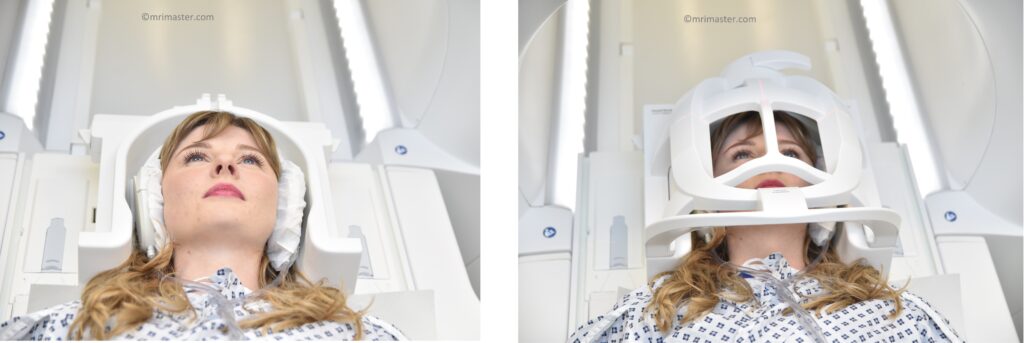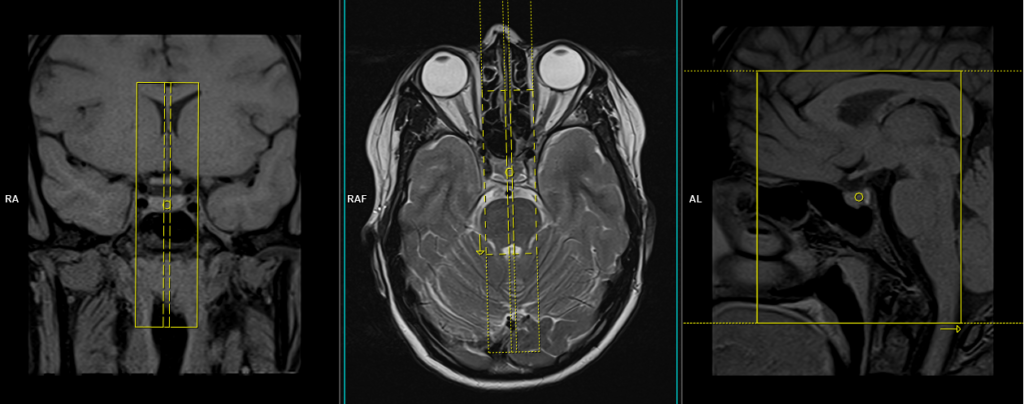Pituitary Dynamic MRI (Protocols and Planning)
Common Indications for dynamic pituitary mri
- Pituitary hypofunction, hormone hypersecretion,
- Visual field defects, bitemporal hemianopia
- Amenorrhea, galactorrhea, infertility
- Diplopia, ptosis, altered facial sensation
- Microadenomas and macroadenomas
- Delayed or frank absence of puberty
- Abnormal height and growth rate
- Decreased libido, impotence
- Nonspecific headache
- Tumour recurrence
- Hypoglycemia
- Dyspareunia
- Obesity
Contraindications
- Any electrically, magnetically or mechanically activated implant (e.g. cardiac pacemaker, insulin pump biostimulator, neurostimulator, cochlear implant, and hearing aids)
- Intracranial aneurysm clips (unless made of titanium)
- Pregnancy (risk vs benefit ratio to be assessed)
- Ferromagnetic surgical clips or staples
- Metallic foreign body in the eye
- Metal shrapnel or bullet
Patient preparation for dynamic pituitary mri
- A satisfactory written consent form must be taken from the patient before entering the scanner room
- Ask the patient to remove all metal objects including keys, coins, wallet, cards with magnetic strips, jewellery, hearing aid and hairpins
- If possible provide a chaperone for claustrophobic patients (e.g. relative or staff )
- Contrast injection risk and benefits must be explained to the patient before the scan
- Gadolinium should only be given to the patient if GFR is > 30
- Offer earplugs or headphones, possibly with music for extra comfort
- Explain the procedure to the patient
- Instruct the patient to keep still
- Note the hight and weight of the patient
Positioning for dynamic pituitary mri
- Head first supine
- Position the head in the head coil and immobilise with cushions
- Give cushions under the legs for extra comfort
- Centre the laser beam localizer over the glabella

Recommended dynamic pituitary mri Protocols and Planning
Pituitary MRI localiser
A three-plane localizer must be taken at the beginning to localize and plan the sequences. Localizers are usually less than 25 seconds and are T1-weighted low-resolution scans.

T2 tse axial 4mm
Plan the axial slices on the sagittal plane and position the block parallel to the genu and splenium of the corpus callosum. Verify the planning block in the other two planes and ensure that an appropriate angle is maintained in the coronal plane, making it perpendicular to the line of the midline of the brain and the 4th ventricle. Ensure that the number of slices is sufficient to cover the entire brain from the vertex to the line of the foramen magnum.

Parameters
TR 4000-5000 | TE 100-120 | SLICE 4MM | FLIP 130-150 | PHASE R>L | MATRIX 320X320 | FOV 210-230 | GAP 10% | NEX(AVRAGE) 2 |
T1 tse DIXON 2mm sagittal SFOV pre contrast
Plan the sagittal slices on the axial plane, and angle the planning block parallel to the midline of the brain. Verify the planning block in the other two planes. Ensure an appropriate angle is given in the coronal plane, parallel to the midline of the brain. Slices should be sufficient to cover the entire pituitary gland from the right to left internal carotid arteries.

Parameters
TR 400-500 | TE 15 | FAT SAT DIXON | NEX 4 | SLICE 2MM | MATRIX 256×256 | FOV 100-120 | PHASE A>P | OVERSAMPLE 100% | GAP 10% |
T2 tse coronal 2mm
Plan the coronal slices on the sagittal plane. Angle the planning block perpendicular to the Sella turcica. Check the planning block in the other two planes. An appropriate angle must be given in the axial plane (perpendicular to the midline of the brain). Slices must be sufficient to cover the whole pituitary gland from the anterior border of the sphenoid sinus to the line of the anterior border of the pons.

Parameters
TR 4000-5000 | TE 110 | FLIP 150 | NEX 4 | SLICE 2MM | MATRIX 256×256 | FOV 100-120 | PHASE R>L | OVERSAMPLE 100% | GAP 10% |
T1 tse DIXON 2mm coronal pre contrast
Plan the coronal slices on the sagittal plane. Angle the planning block perpendicular to the Sella turcica. Check the planning block in the other two planes. An appropriate angle must be given in the axial plane (perpendicular to the midline of the brain). Slices must be sufficient to cover the whole pituitary gland from the anterior border of the sphenoid sinus to the line of the anterior border of the pons.

Parameters
TR 400-500 | TE 15 | FAT SAT DIXON | NEX 4 | SLICE 2MM | MATRIX 256×256 | FOV 100-120 | PHASE A>P | OVERSAMPLE 100% | GAP 10% |
contrast administration and timing of scans
Conducting a dynamic pituitary study with the Guess timing technique:
A dynamic pituitary examination uses one of the simplest contrast monitoring timing methods called the Guess timing technique. It works by estimating the time it takes for contrast to travel from the injection site to the vascular structures of the pituitary gland. This technique is highly dependent on factors such as the site of contrast injection, the patient’s age, cardiac output, and vascular anatomy. Generally, it takes about 4-5 seconds for the contrast to travel from the antecubital vein to the heart and 5-6 seconds to reach the pituitary gland. Therefore, the first acquisition of the dynamic sequence should begin within 8-10 seconds of contrast administration.
Establishing Protocols for Dynamic Pituitary Study
The dynamic pituitary imaging protocol employs a dynamic sequence based on T1 TSE, comprising one pre-contrast acquisition followed by three post-contrast acquisitions. Between the initial and second measurement, there is an 8-second interval. Users should initiate the contrast injection immediately after completing the first measurement. The second measurement will commence automatically after 8 seconds of contrast administration. Typically, the scan protocol is configured with 5 slices, each 3mm thick, utilizing low resolution and a small field of view (FOV). The maximum acquisition time for each measurement should not exceed approximately 25 seconds.
T1 TSE dynamic with 1 pre-contrast 3 post-contrast measurements
Plan the coronal slices on the sagittal plane. Angle the planning block perpendicular to the Sella turcica. Check the planning block in the other two planes. An appropriate angle must be given in the axial plane (perpendicular to the midline of the brain). Slices must be sufficient to cover the whole pituitary gland from the anterior border of the sphenoid sinus to the line of the anterior border of the pons.

Parameters
TR 280-350 | TE 15 | FAT SAT OFF | NEX 1 | SLICE 3MM | MATRIX 192×192 | FOV 130-160 | PHASE R>L | DYNAMIC 4 mesurments | OS 50% |
T1 tse DIXON 2mm sagittal SFOV post contrast
Plan the sagittal slices on the axial plane, and angle the planning block parallel to the midline of the brain. Verify the planning block in the other two planes. Ensure an appropriate angle is given in the coronal plane, parallel to the midline of the brain. Slices should be sufficient to cover the entire pituitary gland from the right to left internal carotid arteries.

Parameters
TR 400-500 | TE 15 | FAT SAT DIXON | NEX 4 | SLICE 2MM | MATRIX 256×256 | FOV 100-120 | PHASE A>P | OVERSAMPLE 100% | GAP 10% |
T1 tse DIXON 2mm coronal post contrast
Plan the coronal slices on the sagittal plane. Angle the planning block perpendicular to the Sella turcica. Check the planning block in the other two planes. An appropriate angle must be given in the axial plane (perpendicular to the midline of the brain). Slices must be sufficient to cover the whole pituitary gland from the anterior border of the sphenoid sinus to the line of the anterior border of the pons.

Parameters
TR 400-500 | TE 15 | FAT SAT DIXON | NEX 4 | SLICE 2MM | MATRIX 256×256 | FOV 100-120 | PHASE A>P | OVERSAMPLE 100% | GAP 10% |



